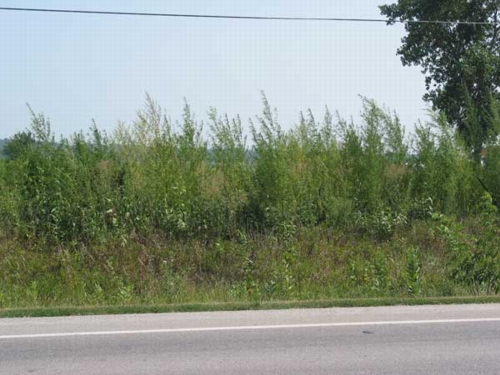
The Hemp Report thanks our loyal readers for their support of this site
and special thanks as well to:
Hemp Resource - www.hemp-resource.com
Canadian Hemp Trade Alliance - www.hemptrade.ca
Ontario Hemp Alliance - www.ontariohempalliance.org
Farmer Direct - www.farmerdirect.ca
Saskatchewan Hemp Association - www.saskhemp.com
The Hemp Industries Association - www.thehia.org
Dr. Bronner's Magic Soaps - www.drbronner.com
IndustrialHemp.net - www.industrialhemp.net
Vote Hemp - www.votehemp.com
![]()
Please Support The Hemp Report

Feral hemp by the roadside in Iowa
The tragic element of this story is that as a result of the pariah status to which hemp was relegated in the US, Kentucky hemp is now extinct. The germplasm produced in Dewey's breeding program and all that collected by the USDA is lost. The National Seed Storage Laboratory, located in Fort Collins, Colorado, is charged with the preservation of germplasm as a safeguard against national disaster, such as nuclear war. In the early 1960s, ten bags of hemp seed, the only known remnant of the Kentucky hemp varieties, were transferred there from the USDA. A USDA Yearbook report noted that "Flax and hemp are no longer produced for fiber in this country, but seed stocks of the best varieties that have been developed by research agencies are maintained." Fortunately for flax, a responsible effort was made to preserve its germplasm. Sadly, the hemp remnant was neglected. At the request of the author, NSSL searched and found these bags of hempseed. Apparently, they were never logged in as accessions of the lab. Consequently, they were not properly preserved. The bags are only labeled with numbers whose import was not recorded, so we cannot know which varieties they might have been. The seed was last grown, as far as can be determined, in 1948.
"Troopers also are responsible for removing wild hemp plants, which were grown under government sanction more than half a century ago to produce rope for World War II naval operations. Last year they removed more than 200 million wild marijuana plants in Northern Indiana."
Cultivated - Marijuana that is deliberately planted, grown, tended
Sinsemilla - Seedless female plant found in plots where male plants have been removed
Tended Wild/Ditchweed - Wild marijuana that shows some human attention such as mulching, feeding, watering, clipping or harvesting
Untended Wild/Ditchweed - Wild marijuana that shows no signs of mulching, feeding, watering, clipping, harvesting
Processed Marijuana - Actual dry smokable marijuana in the drying process, loose or packaged. Include weight, measure in pounds
March 2004 June 2004 July 2004 August 2004 September 2004 October 2004 November 2004 December 2004 January 2005 February 2005 March 2005 April 2005 May 2005 June 2005 July 2005 August 2005 September 2005 October 2005 November 2005 December 2005 January 2006 February 2006 March 2006 April 2006 May 2006 July 2006 August 2006 September 2006 October 2006 November 2006 December 2006 January 2007 February 2007 March 2007 April 2007 May 2007 June 2007 August 2007 October 2007 November 2007 December 2007 January 2008 February 2008 March 2008 April 2008 May 2008 June 2008 July 2008
Please support our current sponsors.
(Click on logo to enter their web site!)
|
Farmer Direct |
Saskatchewan Hemp Association |